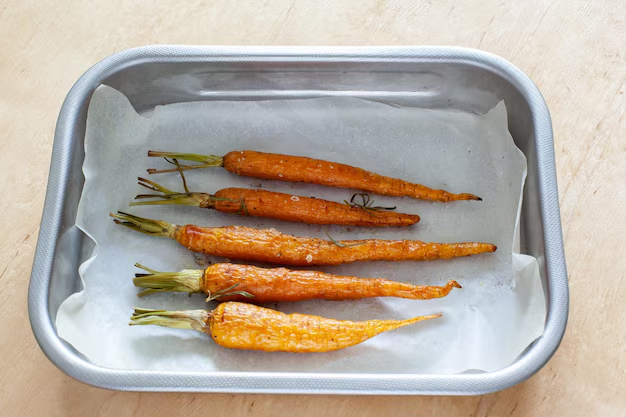Keep Your Carrots Fresh: The Ultimate Guide to Storing Them in Your Refrigerator
Carrots are a staple in kitchens around the world, celebrated for their versatility, nutritional value, and satisfying crunch. Whether you're using them in a hearty stew, a fresh salad, or as a healthy snack, keeping carrots fresh is essential to maintain their flavor and texture. Here’s a comprehensive guide on how to preserve carrots in your refrigerator, ensuring they stay crisp and delicious for as long as possible.
🥕 Understanding Carrot Storage Needs
Before diving into storage methods, it's crucial to understand why proper storage matters. Carrots, like many vegetables, are susceptible to moisture loss and spoilage. The root vegetable's high water content means it can become limp and tasteless if not stored correctly. Keeping carrots fresh involves maintaining the right balance of moisture and temperature.
Why Carrots Spoil
- Water Loss: Carrots can lose moisture to the surrounding air, leading to shriveling.
- Ethylene Gas Sensitivity: Carrots are sensitive to ethylene gas, which can cause them to spoil if stored with ethylene-producing fruits like apples and bananas.
- Temperature Fluctuations: Exposure to fluctuating temperatures can degrade their texture and flavor.
The Basics of Refrigerating Carrots
When it comes to refrigeration, the key is to create an environment that minimizes moisture loss while preventing contamination. Here’s how you can prepare your carrots for optimal storage.
🌿 Preparing Carrots for the Refrigerator
Trim the Greens: If you have bought carrots with their leafy greens still attached, remove them before storage. The greens can draw moisture away from the roots, causing them to wilt faster.
Wash and Dry: Gently wash carrots under cool water to remove any dirt. Thoroughly dry them before storage, as excess moisture can promote mold growth.
Choice of Containers: Consider using perforated plastic bags or airtight containers. These allow for skin breathing, preventing excess moisture accumulation which can lead to rotting.
🌡️ Ideal Refrigeration Conditions
- Temperature: Store carrots in the refrigerator's vegetable crisper at around 32°F to 40°F (0°C to 4°C).
- Humidity: Crisper drawers typically have controllable humidity levels. For carrots, a closer to high humidity setting is preferable to prevent drying out.
Methods for Storing Carrots
🛒 Whole Carrots
- In Perforated Bags: Place whole carrots in a perforated plastic bag to maintain moisture without creating a damp environment.
- In Water: Submerge carrots in water and store in a covered container. Change the water every 4-5 days for prolonged freshness.
🥕 Baby Carrots
- Airtight Containers: Store baby carrots in an airtight container with a damp paper towel to retain their moisture.
- Reuse Water Method: Similar to whole carrots, storing baby carrots submerged in water is effective.
🥄 Cut or Sliced Carrots
- Water Storage: For maximum freshness, cut or sliced carrots can be kept in a bowl of water, ensuring they are fully submerged. This method is best for short-term storage.
Related Topics: Beyond the Basic Storage
🧂 Preserving Flavor with Blanching
Blanching is a process that involves boiling vegetables briefly and then plunging them into ice water. This method can help preserve flavor and nutritional value.
- Boil Water: Bring a pot of water to a rolling boil.
- Blanch Carrots: Add carrots for 2-3 minutes.
- Ice Bath: Quickly transfer them to an ice bath.
- Dry and Store: Once cooled, dry completely and store them in an airtight container.
🥗 Long-Term Storage Options
If refrigeration isn't sufficient for your needs, consider these alternatives:
- Freezing Carrots: Blanch then freeze for a long-term storage solution.
- Pickling: Another preservative method that adds a tangy flavor twist.
📝 Quick Tips for Maximum Freshness
- Avoid Cross-Contamination: Store carrots away from ethylene-producing fruits to prevent spoilage.
- Regular Checks: Inspect for signs of spoilage, like sliminess or unusual odors, and remove affected carrots immediately.
- Batch Organization: Rotate your stock regularly to ensure older carrots are used first.
📋 Handy Summary: Refrigerator Carrot Storage
Here’s a concise table of essential tips to remember:
| 📦 Storage Type | ✔️ Method | 🌡️ Temperature/Conditions | 🔄 Maintenance |
|---|---|---|---|
| Whole Carrots | Perforated bags, Water in container | 32°F-40°F, High humidity | Change water every 4-5 days |
| Baby Carrots | Airtight containers, Water | 32°F-40°F, High humidity | Replace paper towels when dry |
| Cut/Sliced Carrots | Water container | 32°F-40°F | Refresh water regularly |
| Blanched Carrots | After cooling, Airtight containers | Freezer setting | Utilize before spoilage |
Final Insight: The Reward of Proper Storage
Keeping carrots fresh in your refrigerator is more than just a preservation practice; it’s about making the most of your food resources. By following these methods, you can reduce food waste, save money, and enjoy the full flavor and nutrition carrots offer. With attention to details like moisture and temperature, your carrots can be stored effectively, remaining crisp and ready for any culinary adventure. 🥕
Embrace these storage techniques to ensure the bounty of your produce doesn't go to waste. A little effort in proper carrot storage goes a long way in promoting sustainability and enhancing your culinary experiences.
